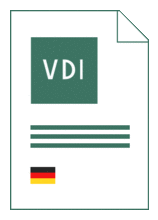Standards Worldwide
Standards Worldwide
Phone +49 30 58885700-07

Technical rule [WITHDRAWN]
VDI 6035:2009-09
Ventilation and air-conditioning technology - Decentralized ventilation systems - Wall-mounted air-conditioners (VDI ventilation code of practice)
- German title
- Raumlufttechnik - Dezentrale Lüftungsgeräte - Fassadenlüftungsgeräte (VDI-Lüftungsregeln)
- Publication date
- 2009-09
- Original language
- German, English
- Pages
- 32
- Publication date
- 2009-09
- Original language
- German, English
- Pages
- 32
Product information on this site:
Quick delivery via download or delivery service
Buy securely with a credit card or pay upon receipt of invoice
All transactions are encrypted
Short description
The content of this guideline has been developed in strict accordance with the requirements and recommendations of the guideline VDI 1000. All rights are reserved, including those of reprinting, reproduction (photocopying, micro copying), storage in data processing systems and translation, either of the full text or of extracts. The use of this guideline without infringement of copyright is permitted subject to the licensing conditions specified in the VDI notices . We wish to express our gratitude to all honorary contributors to this guideline. Introduction The important technically relevant - even cross-disciplinary - requirements for ventilation and air conditioning technology with decentralized ventilation devices, which must be considered for the system design and plant and device design are compiled for the user in this guideline. On the basis of this guideline, building planners, architects and technical planners will be able to plan a decentralized ventilation system that can be operated in an energy-efficient and cost-effective manner. 1 Scope This guideline provides guidelines on the planning, technical requirements and operation of ventilation and air conditioning plants with decentralized ventilation devices for office buildings as well as other non-residential buildings. These plants are used for the ventilation of individual rooms (usage unit), in which the external air is automatically sucked in by a decentralised ventilation device on the façade and after at least one thermodynamic after-treatment, led into the room. This guideline does not consider devices with a centralised or decentralised exhaust in conjunction with external air after-flow in the façade. The delimitation to the centralised ventilation and air conditioning systems has been drawn up such that all such systems are assigned to VDI 3803, in which the components are connected via an air pipe network of the supply air with a centralised ventilation and air conditioning device.
Content
ICS
91.140.30
Replacement amendments
This document has been replaced by: VDI 3803 Blatt 2:2019-06 .
Also available in
Loading recommended items...
Loading recommended items...
Loading recommended items...
Loading recommended items...
